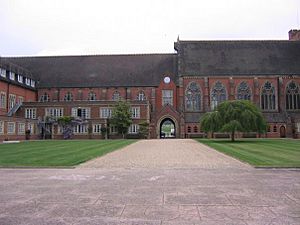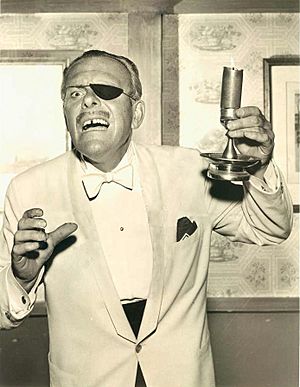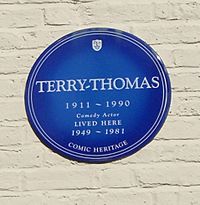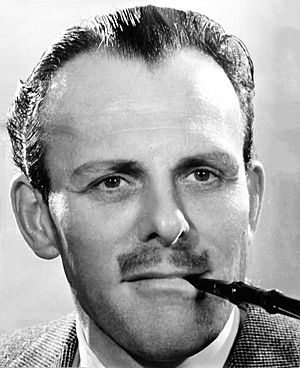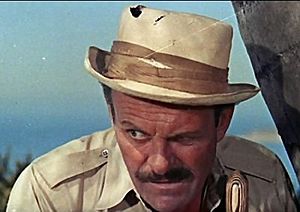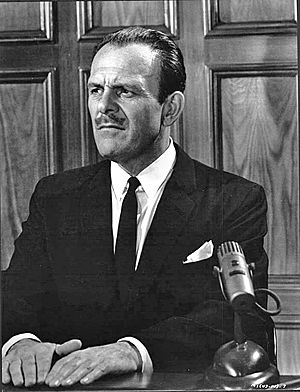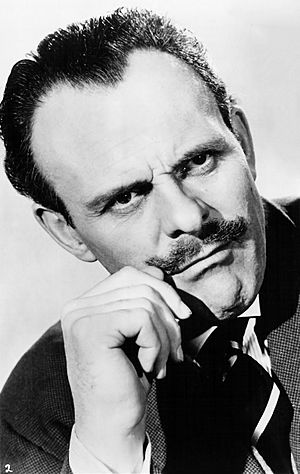Terry-Thomas facts for kids
Terry-Thomas, born Thomas Terry Hoar Stevens (July 10, 1911 – January 8, 1990), was a famous English actor and comedian. He became well-known around the world in the 1950s and 1960s. He often played funny, sometimes sneaky, upper-class characters. He had a very unique voice and look, which included a special gap between his two front teeth. He also often wore a monocle, a waistcoat, and used a long cigarette holder.
Terry-Thomas first appeared in a film in 1933, though he wasn't credited. He spent several years in smaller roles. During World War II, he performed for soldiers with groups like ENSA and Stars in Battledress. This experience helped him become a better comedian and made him more famous. After the war, he starred in a London stage show called Piccadilly Hayride. He also led the first comedy series on British television, How Do You View? (1949). He was popular on BBC Radio and successfully moved into British films. His most creative time was the 1950s, when he appeared in movies like Private's Progress (1956), The Green Man (1956), Blue Murder at St Trinian's (1957), I'm All Right Jack (1959), and Carlton-Browne of the F.O. (1959).
In the early 1960s, Terry-Thomas started acting in American films. These included Bachelor Flat (1962), It's a Mad, Mad, Mad, Mad World (1963), and How to Murder Your Wife (1965). From the mid-1960s, he also appeared in many European films. One famous role was Sir Reginald in the French film La Grande Vadrouille. In 1971, Terry-Thomas was diagnosed with Parkinson's disease. This illness slowly ended his acting career. His last film role was in 1980. He spent a lot of his money on medical care. Later, a charity event was held in his honor. This event raised enough money for him to live in a nursing home for his final years.
Contents
Biography of Terry-Thomas
Growing Up: 1911–1933
Terry-Thomas was born Thomas Terry Hoar Stevens in Finchley, North London. He was the fourth of five children. His father, Ernest Frederick Stevens, was a butcher and an amateur actor. His mother was Ellen Elizabeth Stevens. As a child, he was often called Tom. He had a happy childhood and often entertained his family with jokes, singing, and dancing.
In 1921, Terry-Thomas started to develop his clear, well-spoken voice. He thought that "using good speech automatically suggested that you were well-educated." He based his speaking style on the actor Owen Nares. Terry-Thomas loved the stage and often went to the Golders Green Hippodrome to see shows. There, he became interested in fashion and copied the stylish look of his hero, Douglas Fairbanks.
He attended Fernbank School in Finchley. When he was 13, he moved to Ardingly College, a public school in Sussex. He was good at Latin and geography. He also took drama classes. He was later asked to leave the school because he often made up lines during lessons. He also played the ukulele and percussion in the school jazz band. He often performed funny dance routines with the band's music.
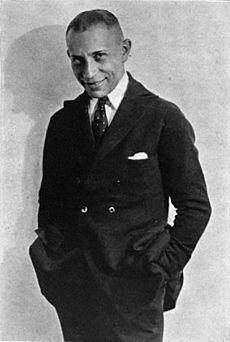
Terry-Thomas enjoyed his time at Ardingly College. He liked being friends with his upper-middle-class schoolmates. He was not a top student, but he was known for his playful behavior. After leaving Ardingly, he worked temporarily at Smithfield Market. He was a junior transport clerk and earned 15 shillings a week.
He often entertained his co-workers with funny impressions. He made up characters and told funny stories about them. His bosses noticed his acting skills and asked him to join the company's drama club. He made his first stage appearance as Lord Trench in The Dover Road. This play was popular, and he became a regular in amateur shows.
Terry-Thomas made his first professional stage appearance on April 11, 1930. He was billed as Thos Stevens. His performance was not well-received by the audience, but he earned 30 shillings. After this, he played small roles in Gilbert and Sullivan shows. In 1933, he left Smithfield Market and briefly worked in an electrical shop. Then he became a traveling salesman for electrical equipment. He liked this job because he could dress up in fancy clothes for his sales pitches. In his free time, he played the ukulele with a local jazz band. He also started dancing and formed a partnership with Jessie Matthews' sister. They performed at local events and earned good money. They were hired as ballroom dancers in Cricklewood. He found the dance style too limiting and left to try other types of entertainment.
Starting Out: 1933–1939
By 1933, Terry-Thomas had moved to a friend's flat. His friend was a film extra and introduced him to the movie industry. Terry-Thomas made his first uncredited film appearance in The Private Life of Henry VIII (1933). Between 1933 and 1941, he appeared in 16 films, mostly as an extra. He said this work suited him well and felt like fun. His first speaking role was in the 1935 comedy Once in a Million. He shouted "A thousand!" during an auction scene. During the 1936 musical comedy This'll Make You Whistle, he permanently damaged his hearing. This happened when he jumped into a water tank. When not filming, he worked on his cabaret act and taught dance.
He first used the name Thomas Stevens, then Mot Snevets (his name backward). He then changed it to Thomas Terry, and finally to Terry Thomas. He added the hyphen in 1947. He said it was "to tie the two names together" and "to match the gap in his front teeth." He developed a unique style. He used a cigarette holder to avoid staining his fingers. He also wore a monocle, a stylish waistcoat, and a red flower. He later wrote that he was "an eccentric" in his clothes, but "underneath the clothes I was very much a conservative Englishman."
In 1937, Terry-Thomas met Ida Florence Patlansky, a dancer. She wanted him as a comedian for her flamenco act. They formed a popular cabaret act called "Terri and Patlanski." They got married on February 3, 1938. Despite their success, the act only lasted three months. They then took on smaller cabaret jobs. On June 6, 1938, Terry-Thomas made his first radio broadcast on the BBC. He later said he was "a dismal failure." In late 1938, they joined a band. Patlanski played piano, and Terry-Thomas was the master of ceremonies.
World War II Service
The Entertainments National Service Association (ENSA) was created in 1938 to entertain British soldiers. Terry-Thomas and Patlanski joined in 1939. They performed in France during the early part of the war. When he returned to Britain, he continued his solo act. He also led the cabaret section of ENSA at the Theatre Royal, Drury Lane. He wanted to produce "good shows, sophisticated, impeccable and highly polished."
In April 1942, Terry-Thomas was called up for military service. He joined the Royal Corps of Signals. Within two weeks, he organized a concert at Ossett Town Hall. He performed a new sketch about his feet hurting in army boots. After basic training, he became a corporal. He tried to become an officer but was turned down due to health issues.
Terry-Thomas continued to perform in shows while in the army. He was seen by George Black, who created the Stars in Battledress entertainment group. This group was made up of entertainers serving in the forces. Terry-Thomas joined in February 1943. He performed his sketch "Technical Hitch." In this sketch, he played a BBC announcer who had to cover up for missing records. He would mimic singers using his wide vocal range. The show toured nationally, and Terry-Thomas became a very important member of Stars in Battledress.
Terry-Thomas and his unit toured Britain and Europe for several months. As his military service ended, he took leave to perform on a UK tour organized by George Black. He finished the war as a sergeant and was released from service on April 1, 1946.
Post-War Success: 1946–1955
The tours during the war made Terry-Thomas very well-known. By October 1946, he was performing in Piccadilly Hayride in London. This show was a huge success. Terry-Thomas was the compere and also performed his "Technical Hitch" routine. He said, "This show made me overnight. I'd arrived." A critic praised his "glorious rag of BBC modes." Within three weeks, he was invited to perform at the Royal Command Performance.
Piccadilly Hayride ran for 778 shows and ended in January 1948. Over a million people saw the show. Terry-Thomas also made other appearances in cabaret and on BBC Radio. His act included impressions, sketches, and funny stories. After Piccadilly Hayride, he took a break to recover from exhaustion. He then returned to cabaret and became a compere at the London Palladium.
On October 12, 1948, he got his own radio series, To Town with Terry. It featured sketches, solo routines, and guest stars. He was not completely happy with the series, saying he was "never totally satisfied." In 1949, he also appeared in his first post-war film, A Date with a Dream.
On October 26, 1949, Terry-Thomas wrote and starred in a new series on BBC Television, How Do You View?. This was the first comedy series on British television. He played a charming but slightly poor man-about-town. He appeared in sketches with other actors. The show was broadcast live and often showed Terry-Thomas walking through the BBC studios. A historian described the series as "inventive" and "truly televisual." The show ran for five series, ending in June 1952. A writer noted that Terry-Thomas had "physical attributes that make him a gift to visual entertainment," including his famous tooth gap and cigarette holder.
While filming How Do You View?, Terry-Thomas continued to perform on radio and in cabaret in Britain and the US. He appeared in Chicago and New York. From December 1951 to February 1952, he returned to the London Palladium for 109 performances in Humpty Dumpty. In September 1952, he traveled to Malaya to entertain British troops. He then returned to the UK for the Royal Variety Performance. He ended the year in South Africa, performing in a pantomime.
In June 1953, Terry-Thomas broadcast the pilot for the radio show Top of the Town. It was successful, and the BBC ordered a series of 16 episodes. He also appeared at the London Palladium in the show Fun and the Fair. This show was not successful and closed after 138 performances. Terry-Thomas then performed in other pantomimes. In 1954, he separated from his wife, Patlanski. They had been living separate lives for some time. The press did not report their separation until 1957.
Terry-Thomas spent the summer of 1954 performing in Blackpool. He then starred in a second series of Top of the Town. After that, he appeared in the play Room for Two. During a tour of the play, he broke his arm on stage. He returned to the show five days later. He joked that the audience laughed so much when he fell that he thought about breaking his other arm for an encore. The London run of the show was not a success.
British Film Star: 1956–1961
In February 1956, Terry-Thomas appeared on Desert Island Discs. Later that year, he got his first major film roles. He played Charles Boughtflower in The Green Man and Major Hitchcock in Private's Progress. Major Hitchcock was a dishonest military officer. Terry-Thomas only appeared briefly in Private's Progress, but he almost "stole the show." He was initially unsure about the role, but his agent convinced him. One of his lines, "You're an absolute shower," became a famous phrase for him. The directors were so impressed that they signed him for a five-film deal.
The first of these films was Brothers in Law. Terry-Thomas played Alfred Green. One scene took 107 takes because Terry-Thomas was new to filming techniques. He struggled to hit his marks and deliver lines while acting. The director said it was a "unique experience" for him. After Brothers in Law, he played Romney Carlton-Ricketts in Blue Murder at St Trinian's. He also appeared as a policeman in Happy Is the Bride.
Terry-Thomas starred in two more films in 1957. He was Bertrand Welch in Lucky Jim. A critic thought he was "the nearest to a complete success" in the film. His last role of 1957 was Lord Henry Mayley in The Naked Truth. This film brought him together with Peter Sellers for the first time. They often appeared together, and their performances highlighted each other's skills. During one scene, Terry-Thomas was dumped in a freezing lake, which affected his health.
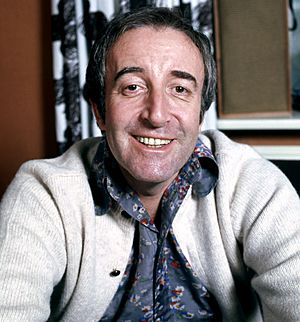
In 1958, Terry-Thomas was nominated for a BAFTA Award for "Best British Actor" for his role as Ivan in tom thumb. He later said this was his second favorite film. He appeared opposite Peter Sellers. Terry-Thomas was still unwell from filming The Naked Truth when he got a back injury. Filming for tom thumb lasted 85 days, and he took painkillers to continue. The role was physically demanding, requiring him to ride a horse, run, and fight. He said he fought and ran like Douglas Fairbanks Snr in The Mark of Zorro. For the rest of 1958, Terry-Thomas performed on stage in Large as Life. He also released his first record, Strictly T-T, a collection of funny songs.
In 1959, Terry-Thomas published his first autobiography, Filling the Gap. He said, "everything that has been printed about me is lies. I'm not suggesting the writers were lying, I was." That year, he also appeared in two more films by the Boulting brothers. The first was Carlton-Browne of the F.O., where he played Cadogan de Vere Carlton-Browne. He described the character as "rubble from the nostrils up," a certain type of Englishman. The film was almost withdrawn from a film festival because the Foreign Office worried it might show British diplomats inaccurately.
Terry-Thomas's last film with the Boulting brothers was I'm All Right Jack. He played Major Hitchcock again, this time as a "tetchily incompetent" personnel manager. Many actors from Private's Progress returned. Peter Sellers received much praise, but critics also noted Terry-Thomas's "extraordinary skill." His final film of 1959 was Too Many Crooks. A critic said Terry-Thomas showed "some of the fieriest conniptions to be seen on the contemporary screen." He filmed during the day and performed at the London Palladium in the evenings, which he found tiring.
In 1960, Terry-Thomas appeared as Raymond Delauney in School for Scoundrels. His biographer called this film "the definitive screen presentation of his frightfully well-mannered, well-read and well-educated lounge lizard." He appeared with Ian Carmichael again. A film institute writer thought Terry-Thomas was "outstanding as a classic British bounder." CNN listed this performance among the top 10 British villains. Later that year, he played Major Albert Rayne in Make Mine Mink. He played a World War II veteran who forms a gang of mink coat thieves.
In 1961, Terry-Thomas played Archibald Bannister in A Matter of WHO. He called this his "first (fairly) serious role." His cousin's son, Richard Briers, was also in the film. The film was not well-received by critics but was successful in America. By this time, Terry-Thomas decided to stop being a stand-up comedian and focus only on films. He stopped appearing on his own TV and radio shows. He declared, "it was the cinema for me and me for the cinema!" With much experience in British films, he decided to try Hollywood and moved to America.
Hollywood Adventures: 1961–1965
Terry-Thomas spent part of 1961 in America filming Bachelor Flat, his first Hollywood role. Then he flew to Gibraltar to film Operation Snatch. By the end of 1961, he was appearing on American radio and TV shows. He was often interviewed by US newspapers. In 1962, Bachelor Flat and Operation Snatch were released. He also appeared in The Wonderful World of the Brothers Grimm and Kill or Cure.
On February 1, 1962, Terry-Thomas and Pat Patlanski divorced after eight years of separation. He then started a romance with Belinda Cunningham, whom he married in August 1963. The following year, their first son, Timothy Hoar, was born.
In 1962, Terry-Thomas was offered a role in It's a Mad, Mad, Mad, Mad World. He first turned it down but changed his mind on his flight to London. He called the producer from the airport to accept and flew back the same day. He found it challenging to work with many of the American actors. He said, "I was the only non-American, and I found it exhausting and embarrassing because they never relaxed." He admired Spencer Tracy and Buster Keaton, who were also in the film.
In 1963, he was nominated for a Golden Globe for Best Comedy Actor for his role in The Mouse on the Moon. He also tried producing three short travel films. He did not enjoy being a producer. He worked steadily in 1963, appearing on TV shows in both the US and UK. This included a one-off variety show on BBC Television.
In 1964, Terry-Thomas started filming How to Murder Your Wife. This role earned him his largest fee yet. He said it was his favorite film to make because he felt he did a very good job. He enjoyed working with Jack Lemmon, the film's star. They became friends. Throughout the rest of the year, Terry-Thomas continued to appear on US television. He also released another record, Terry-Thomas Discovers America, a collection of songs and sketches.
Besides How to Murder Your Wife, two more Terry-Thomas films were released in 1965. These were Strange Bedfellows and Those Magnificent Men in their Flying Machines. In the latter, he played Sir Percy Ware-Armitage, a "cartoon version" of his usual character. He appeared with Eric Sykes again, which Sykes described as magical. The roles for Ware-Armitage and his sidekick were written especially for Terry-Thomas and Sykes.
European Films: 1966–1970
By the mid-1960s, Terry-Thomas was getting tired of Hollywood. He started working with European filmmakers, returning to the US only for specific films. In one of his French films, La Grande Vadrouille, he played Sir Reginald, a stranded Royal Air Force pilot. He traveled through occupied France with other characters. This film, released in 1966, was a huge box-office success in France. Terry-Thomas also took on many roles in Italian films. For the 1967 film Arabella, he played four different characters.
Even though European films gave him steady work, he earned more money from his less frequent US film roles. He joked that "the fat cheques in the pipe-line were endless." One large fee came from Gene Kelly's 1967 film A Guide for the Married Man. He was disappointed by Kelly's directing. He shared a short scene with Jayne Mansfield and found her intelligent. He had difficulties working with Doris Day in the 1968 film Where Were You When the Lights Went Out?. Day would tell him how to act, but he would do it his own way. She also improvised during filming, but the director would cut that material. The film was not well-received.
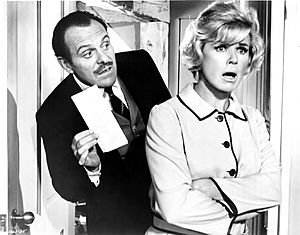
In 1967, Terry-Thomas met his friend Denholm Elliott in Bel Air. They talked about Elliott's new villa in Ibiza, Spain. Terry-Thomas was interested in a Mediterranean home and visited the island. He eventually found a good location and designed the house himself. His former wife Pat moved to a nearby island, and their relationship became friendly. Patlanski also became good friends with Terry-Thomas's wife.
Between films, Terry-Thomas appeared on television in both the US and UK. In 1967, he was in "The Five Daughters Affair" on The Man from U.N.C.L.E. and on The Red Skelton Hour. On British television, he played James Franklin-Jones in The Old Campaigner. This character was another version of his charming cad persona. The episode was popular, and a six-part series was ordered. Although the series did well, a second series was not made. In 1968, Terry-Thomas appeared in a British ITV variety special. He seemed to enjoy bringing back his sophisticated humor. In 1969, he teamed up with Eric Sykes and director Ken Annakin again for Monte Carlo or Bust!. Terry-Thomas played Sir Cuthbert Ware-Armitage, the "thoroughly bad egg son" of his character from Those Magnificent Men. He also had four other minor film roles that year and appeared on TV in the UK, US, and Australia.
The 1970s started well for Terry-Thomas. He had TV appearances and filmed The Abominable Dr. Phibes, which was released in 1971. On August 1, 1970, Terry-Thomas made his second appearance on Desert Island Discs.
Living with Parkinson's: 1971–1983

In 1971, while performing in Sydney, Terry-Thomas felt unwell. A doctor noticed his left hand shaking. The doctor suggested he see a specialist in the UK, who diagnosed him with Parkinson's disease. Terry-Thomas kept the news private at first, fearing it would affect his work. But as his symptoms worsened, he made the news public.
Terry-Thomas continued to work as much as possible. However, his condition limited him to supporting roles and cameos. A notable role was the voice of Sir Hiss in the 1973 Walt Disney film Robin Hood. Other roles were in less famous films like The Vault of Horror. He also continued to appear on TV shows and in advertisements. He appeared with June Whitfield for Birds Eye fish fingers and in award-winning ads for Benson & Hedges with Eric Sykes.
During the 1970s, he starred in several low-budget British films, including Spanish Fly.
In 1977, he starred in The Last Remake of Beau Geste and The Hound of the Baskervilles. He thought The Hound of the Baskervilles was "the most outrageous film I ever appeared in." By then, his movements had slowed, a sign of his worsening condition. His voice had softened, and his posture was affected. Between 1978 and 1980, he spent much time with medical experts. Despite this, he was offered some jobs. He was voted the most recognizable Englishman among Americans in a poll. This led to a profitable advertising contract with the Ford Motor Company. Derek Jarman offered him a role in his 1979 film The Tempest, but Terry-Thomas had to withdraw due to his declining health.
Terry-Thomas took his final film role in 1980 in Febbre a 40!, a German-Italian film that was not widely shown. He continued to be involved in the film industry, funding three films in the early 1980s. He joked that he "made a loss of one hundred per cent." In 1982, as his condition worsened, Terry-Thomas appeared in two episodes of the BBC series The Human Brain. He discussed his condition openly, which raised public awareness of Parkinson's disease and £32,000 for the Parkinson's Disease Society. Privately, he became more depressed. His London flat was sold to help with funds, and work offers decreased.
Final Years and Passing: 1983–1990
By 1983, Terry-Thomas's medical bills were very high, and he could no longer work. His money was running out. He and his wife sold their home and moved into a small cottage in Spain. This cottage had been left to him by his former wife, Pat Patlanski, after her death. Soon after, he worked on an autobiography, Terry-Thomas Tells Tales. He never fully finished editing the book, and it was published after his death.
By 1984, Terry-Thomas was very depressed by his condition. He admitted that a doctor said he had about four more years to live. In 1987, he and his wife could no longer afford to live in Spain and moved back to London. They lived in rented places before moving into a charity flat. They received financial help from the Actors' Benevolent Fund. Richard Briers, his cousin's son, visited him and was shocked by his appearance.
On April 9, 1989, actors Jack Douglas and Richard Hope-Hawkins organized a benefit concert for Terry-Thomas. They found out he was living in poverty and poor health. The gala, held in London, lasted five hours and featured 120 artists. Phil Collins was the main performer, and Michael Caine was the chairman. The show raised over £75,000 for Terry-Thomas and Parkinson's UK. The money allowed Terry-Thomas to move into a nursing home in Godalming, Surrey. He passed away there on January 8, 1990, at age 78. His funeral service was held at St. John the Baptist Church. The theme from Those Magnificent Men in their Flying Machines was played.
His Acting Style
Terry-Thomas saw himself as a comedy actor. He believed he was "first and foremost, as a comedian with a built-in ability to inject humour into situations." He worked hard on his comedy, especially during his early cabaret days. He wrote that he spent a lot of time studying how to write humor.
When working on his TV series How Do You View?, he would change lines to make sure the scene worked well. He even gave the best lines to other actors. This quality was appreciated by many, including Jack Lemmon. Lemmon said that Terry-Thomas was "generous to fellow actors. He worked with you, not at you."
Before filming or going on stage, Terry-Thomas had a routine. He would "jump in the air and execute a few dance steps." For many of his film roles, he would underplay his reactions. For a close-up scene in Private's Progress, he needed to show "shock, fury, indignation." He said he "just looked into the camera and kept my mind blank. It's a trick I've used often since. In this way, the audience does the work." Terry-Thomas also liked to do his own stunts, even dangerous ones. For example, in Those Magnificent Men in their Flying Machines, he ran along the roof of a moving train.
Terry-Thomas's Lasting Impact

Terry-Thomas's image as a charming English cad influenced others. In the 1960s, the voice actor Ivan Owen based the voice for Basil Brush on Terry-Thomas. This character also copied Terry-Thomas's love for bad, self-satisfied jokes. The cartoon character Dick Dastardly in Wacky Races and Dastardly and Muttley in Their Flying Machines was also inspired by Terry-Thomas.
Other actors have used Terry-Thomas's style as inspiration. Dustin Hoffman said he based his Captain Hook in Hook on him. Rupert Everett said Terry-Thomas was his "vocal role model" for Prince Charming in Shrek 2. Paul Whitehouse's character, the 13th Duke of Wybourne, from The Fast Show was also modeled on Terry-Thomas.
Terry-Thomas remained popular after his death. In February 1999, the National Film Theatre showed a season of his films. A spokesman said people came dressed up, with fake mustaches and long cigarette holders. He added, "We've never had a response like it. Nobody expected Terry-Thomas Fever."
Some of Terry-Thomas's early TV show ideas were later copied. How Do You View? used a "prologue" format, similar to Up Pompeii!. It was also the first to use BBC announcers in comedy sketches, a practice continued by Morecambe and Wise. Terry-Thomas's way of telling long, funny stories inspired Ronnie Corbett in his monologues on The Two Ronnies. In 2014, BBC Radio 4 broadcast Memories of a Cad, a comedy-drama about Terry-Thomas and Richard Briers.
Filmography and Other Works
Images for kids
See also
 In Spanish: Terry-Thomas para niños
In Spanish: Terry-Thomas para niños


